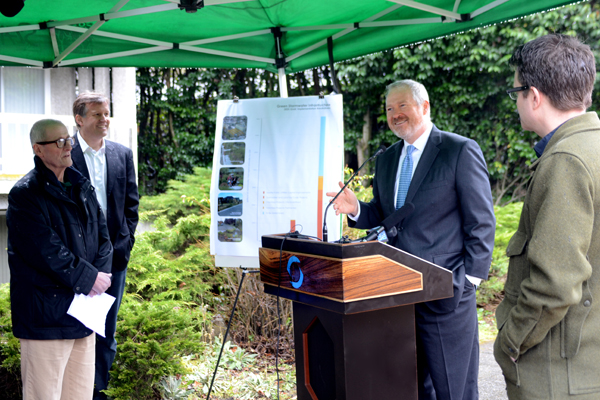VIDEO: Seattle Strategy for Green Stormwater Infrastructure – “GSI is an approach for mimicking the way intact forest ecosystems manage rainfall, to prevent stormwater pollution and make our neighborhoods greener and more livable at the same time,” stated Tracy Hackett
Note to Reader:
In March 2013, former Seattle Mayor Mike McGinn announced a new goal for managing Seattle’s rainwater runoff by detailing a new effort where polluted runoff will be increasingly managed using natural drainage systems rather than traditional pipe and tank systems. In July 2015, the City of Seattle adopted a strategy to accelerate adoption of Green Stormwater Infrastructure. To download a copy, click on Implementation Strategy 2015-2020
Tracy Tackett, PE is the Green Stormwater Infrastructure (GSI) Program Manager for Seattle Public Utilities. She is responsible for the management, direction and decision making for capital improvement projects and significant policies focused on using GSI to reduce the effects of Seattle’s urban stormwater runoff on receiving water bodies.
The image below is a link to a talk by Tracy Hackett. She provides an overview of green stormwater infrastructure (GSI) in Seattle. GSI is an approach for mimicking the way intact forest and prairie ecosystems manage rainfall, to prevent stormwater pollution and make Seattle neighborhoods greener and more livable at the same time. The talk invites everyone in Seattle to be part of the solution by committing to managing 1000 gallons of runoff annually with GSI.
To see other videos in this series and to learn more about SustainabilityTALKS go to sustainabilityambassadors.org/sustainabilitytalks
Seattle Strategy Builds on 2013 Initiative to Reduce Polluted Urban Runoff and Protect Puget Sound
 In 2015, and in light of polluted stormwater runoff threatening water quality in Puget Sound, former Seattle Mayor Edward B. Murray released a draft citywide Green Stormwater Infrastructure Strategy, outlining plans to accelerate green infrastructure approaches for preventing this type of water pollution.
In 2015, and in light of polluted stormwater runoff threatening water quality in Puget Sound, former Seattle Mayor Edward B. Murray released a draft citywide Green Stormwater Infrastructure Strategy, outlining plans to accelerate green infrastructure approaches for preventing this type of water pollution.
Rainfall rushing off hard surfaces such as roads and parking lots can overwhelm piped drainage systems and cause backups and combined sewer overflows. The runoff also carries pollution directly into creeks, lakes and other waterways.
The Goal for Year 2020: Manage 400 Million Gallons
Green Stormwater Infrastructure (GSI) prevents overflows and pollution much like a forest would — by slowing and cleaning the water and either reusing it or allowing it to soak back through the soil. Examples of GSI include roadside bioretention swales and street trees that manage street runoff; rain gardens and cisterns that manage roof runoff; and green roofs and permeable pavement that are self-managing.
“Green stormwater infrastructure is a valuable tool for us, because it helps us prevent stormwater pollution and greens our neighborhoods at the same time,” said Mayor Murray. “This win-win combination is critically important.”
In 2013, Seattle City Council Resolution 31459 challenged Seattle to rely on GSI to manage stormwater runoff wherever possible and set an aggressive target to manage 700 million gallons of stormwater runoff annually with GSI by the year 2025 — a seven-fold increase over the city’s 2012 baseline.
The draft Strategy sets an interim goal of managing 400 million gallons of stormwater runoff annually with GSI by the year 2020, summarizes progress to date, outlines a set of strategies and planned investments for accelerating the adoption of GSI in Seattle, and articulates a two-year work plan for City of Seattle departments.
Strategy Emphasizes Partnerships
The most significant increases are expected from projects led and funded by Seattle Public Utilities and King County Wastewater Treatment Division, voluntary retrofits on private property, and projects required by Stormwater Code. The Strategy also emphasizes promising opportunities for new partnerships to protect Seattle’s creeks, prevent combined sewer overflows into Puget Sound, and develop integrated transportation projects.
 “Whether it’s a homeowner installing a rain garden, or a commercial property with a green roof and rain-absorbing pavement, there are steps we can all take to prevent polluted runoff and give Puget Sound a break,” said King County Executive Dow Constantine.
“Whether it’s a homeowner installing a rain garden, or a commercial property with a green roof and rain-absorbing pavement, there are steps we can all take to prevent polluted runoff and give Puget Sound a break,” said King County Executive Dow Constantine.
“While natural drainage approaches have been central to our work for nearly fifteen years, this Strategy guides us in redoubling our efforts to accelerate adoption,” said Ray Hoffman, Director of Seattle Public Utilities. “For us, this means building innovative partnerships with sister agencies, community organizations, and project developers, and supporting Seattle residents’ efforts to manage their stormwater on-site.”
To Learn More:
To read an article posted in 2013 on the waterbucket.ca website, click on Rainwater Management in Seattle: Mayor’s Executive Order directs a coordinated approach to increased use of natural drainage systems.
In March 2013, former Seattle Mayor Mike McGinn announced a new goal for managing Seattle’s rainwater runoff by detailing a new effort where polluted runoff will be increasingly managed using natural drainage systems rather than traditional pipe and tank systems.
Visit Green Stormwater Infrastructure


